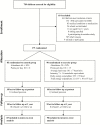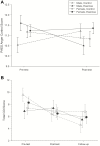Exercise effects on quality of life, mood, and self-worth in overweight children: the SMART randomized controlled trial
- PMID: 31094443
- PMCID: PMC6520810
- DOI: 10.1093/tbm/ibz015
Exercise effects on quality of life, mood, and self-worth in overweight children: the SMART randomized controlled trial
Abstract
Overweight children are at risk for poor quality of life (QOL), depression, self-worth, and behavior problems. Exercise trials with children have shown improved mood and self-worth. Few studies utilized an attention control condition, QOL outcomes, or a follow-up evaluation after the intervention ends. The purpose is to test effects of an exercise program versus sedentary program on psychological factors in overweight children. One hundred seventy-five overweight children (87% black, 61% female, age 9.7 ± 0.9 years, 73% obese) were randomized to an 8 month aerobic exercise or sedentary after-school program. Depressive symptoms, anger expression, self-worth, and QOL were measured at baseline and post-test. Depressive symptoms and QOL were also measured at follow-up. Intent-to-treat mixed models evaluated intervention effects, including sex differences. At post-test, QOL, depression, and self-worth improved; no group by time or sex by group by time interaction was detected for QOL or self-worth. Boys' depressive symptoms improved more and anger control decreased in the sedentary intervention relative to the exercise intervention at post-test. At follow-up, depressive symptoms in boys in the sedentary group decreased more than other groups. Exercise provided benefits to QOL, depressive symptoms, and self-worth comparable to a sedentary program. Sedentary programs with games and artistic activities, interaction with adults and peers, and behavioral structure may be more beneficial to boys' mood than exercise. Some benefits of exercise in prior studies are probably attributable to program elements such as attention from adults. Trial Registration: Clinicaltrials.gov, NCT02227095.
Keywords: Aerobic exercise; Anger; Black; Depressive symptoms; Obesity.
© Society of Behavioral Medicine 2019. All rights reserved. For permissions, please e-mail: journals.permissions@oup.com.
Figures
References
-
- N. C. D. Risk Factor Collaboration. Worldwide trends in body-mass index, underweight, overweight, and obesity from 1975 to 2016: a pooled analysis of 2416 population-based measurement studies in 128.9 million children, adolescents, and adults. Lancet. 2017;390(10113):2627–2642. doi:10.1016/S0140-6736(17)32129-3 - DOI - PMC - PubMed
-
- Williams J, Wake M, Hesketh K, Maher E, Waters E. Health-related quality of life of overweight and obese children. JAMA. 2005;293(1):70–76. - PubMed
-
- Wynne C, Comiskey C, Hollywood E, Quirke MB, O’Sullivan K, McGilloway S. The relationship between body mass index and health-related quality of life in urban disadvantaged children. Qual Life Res. 2014;23(6):1895–1905. - PubMed



